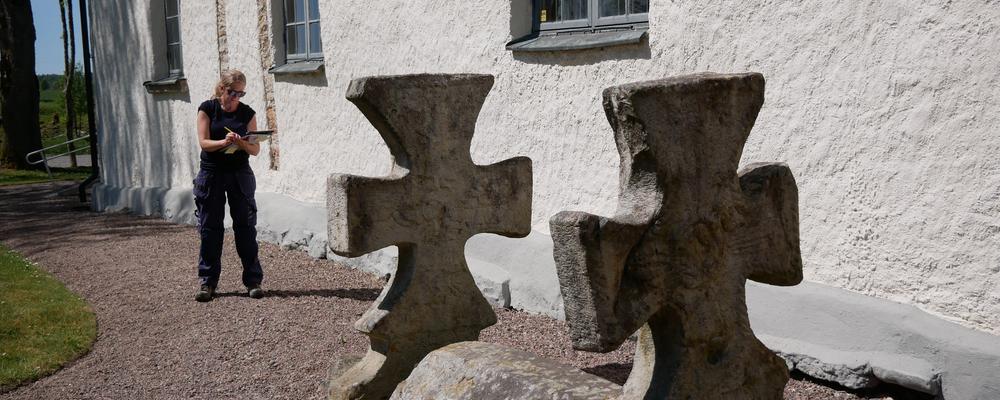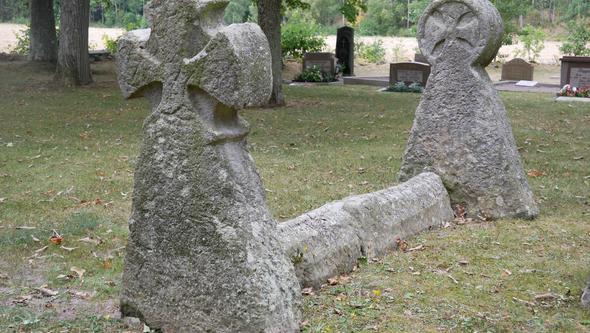
- Home
- News and events
- Find news
- Grave monuments were ‘ammunition’ in the formation of the Kingdom of Sweden
Grave monuments were ‘ammunition’ in the formation of the Kingdom of Sweden
In a time when royal power and Christianity were as yet young in Sweden, the established social and political orders were turned upside down. For the old Västgötaland aristocracy, lavish monuments became an effective tool in their struggle to retain the influence that by custom they believed they were entitled to. For other groups – the “upstarts” of the times – grave monuments became a way to amplify their position, strengthen ties, and acquire influence.

There are plenty of 12th and 13th century monuments in rural Västgötaland. With more than 600 known monuments, the extensive production of such grave monuments in the province of Västergötland has no equivalent in other provinces in Sweden.
In previous research, grave monuments have primarily been regarded and studied as part of medieval art production. However, a new doctoral thesis shows that grave monuments erected in medieval churchyards in the area around Lake Vänern were more than just prestigious gravestones and memorials to the dead.
“Through the use of text, imagery and stone materials, the monuments were thought to be able to help the deceased on their passage to heaven, while also serving as instruments of political power as part of a strategy to secure position and dominance during a period of social upheaval in the 12th and 13th centuries,” says Anna Nyqvist Thorsson, doctoral student at the University of Gothenburg.
The social elites: far from an homogeneous group
Form, text and imagery from the past were at times borrowed and emphasised, but they could also be actively excluded.
“Style choices have been linked to the actions of different social groups, which in turn indicates that the social and political elites in the 12th and 13th centuries were far from the homogeneous stratum of society depicted in previous scholarship. Instead, the grave monuments demonstrate that these elites were both dynamic and stratified.”
Historiography is dominated by visible actors such as the monarchy and the church, but through these grave monuments it has also been possible to identify other groups, such as an old aristocracy and a new social group with ambitions to advance in society. In the thesis, this group are somewhat playfully referred to as the “upstarts”.
“By commissioning exclusive grave monuments, they wanted to compete with and take place in the highest strata of society. The grave monuments became a way to demonstrate that they were ‘just as good’ as the old aristocracy that had long since dominated the local community. At the same time, they were a way for the upstarts to clearly materialise their repudiation of the old elites by omitting entirely old-fashioned imagery and texts that were held dear by the old aristocracy.”
Upstarts jockeying for position

New public offices made it possible for these ‘upstarts’ to be recognised and influence decision-making. The established position of dominance and influence in society that families of ancient lineages had taken for granted was rocked to its foundations.
Sandstone grave monuments, artistically designed with sculpted crosses, braided ribbons and twisted ropes, and with imagery of everything from armed fighting warriors and slithering monsters to purist motifs such as crosses and trees of life, were produced at the same time as one of the bloodiest feuds in Swedish history was taking place. The Houses of Eric and Sverker were battling for power by forming alliances and using violence as a strategy. With the Pope-friendly House of Sverker in power, the old aristocracy of Västgötaland lost its influence over both the election of the king and ecclesiastical matters.
Resistance to royal power
Commissioning grave monuments that borrowed stylistic traits from the past linked the old families to contexts where their influence and dominance were both legitimate and taken for granted. This meant that resistance to royal power and the church’s claims to power were materialised, made concrete, and in addition immortalised, in stone.
Anna Nyqvist Thorsson’s study is based on the grave monuments themselves, but also the graves that she examined, historical sources and conditions described in agrarian history. The thesis describes an almost timeless pursuit of power, influence and the desire to obtain an advantageous socio-political position.
“The grave monuments remain in place as the petrified actors from an era fraught with social and political turbulence.”
The doctoral thesis “When others see. Grave monuments, social practice and collective actors during the 12th and 13th centuries in the Lake Vänern region” was defended on 11 June 2021.
Link to thesis: http://hdl.handle.net/2077/68116. It can also be ordered from Föreningen Västsvensk Arkeologi [West Sweden archaeological association]: info@vastsvenskarkeologi.se.
Contact:
Anna Nyqvist Thorsson, phone: +46 (0)701-77 22 12, email: anna.nyqvistthorsson@vastsvenskarkeologi.se
Text: Johanna Hillgren

